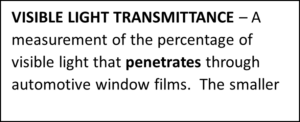Window Tinting Laws
Most people are aware that there are State laws governing the application of automotive window films, but it has been our experience that there are many, widespread misunderstandings among the populace about what these regulations actually are. The goal of this post is to illuminate some of the less transparent aspects of Oregon’s automotive window tinting regulations.
Visible Light Transmittance – What is it?
The first and most important definition we need to learn in the context of window film is the term visible light transmittance, often abbreviated as “VLT.”
All automotive window film manufacturers make their products in a variety of what are typically called “shades”, that is, varying degrees of darkness. Some are what might be called “extremely dark”, while others could be described as “a light tint”. But these are imprecise, subjective terms. So, rather than using vague words like “light”, “darker”, and “darkest”, the industry standard is to use a scientific measurement to precisely quantify the percentage of visible light that passes through the material.

The visible light transmittance of window films is measured with a device that emits a beam of light of a known strength across a small gap to a sensor. The material being measured is inserted into that gap, and the corresponding weakness of the beam is measured by the sensor, thereby detecting the amount of visible light that penetrates through that material.
For example, a completely clear material – such as kitchen cling wrap – would theoretically admit 100% of the available light, and one would therefore say that the material has a visible light transmittance of 100%. Conversely, a material that was completely opaque and admitted no light – such as a sheet of aluminum foil – would have a visible light transmittance, or VLT of 0%. A window film with a VLT measurement of 30% is admitting 30% of the light, and impeding the remaining 70%. The lens of a typical welding helmet generally has a VLT of about 5% or less.
Using VLT to quantify how dark window films are is a great way to avoid ambiguity. Naturally, when lawmakers want to regulate how dark the windows should be on a car, they need a reliable, standard metric to use, and VLT is the obvious choice. However, VLT is only part of the story. Where window film laws start to get confusing is when you start factoring in the glass itself.
Automotive glass
Because we can see through glass, there is a natural tendency to think of glass as “clear”. And indeed, much of the glass that we encounter in our daily lives is specifically engineered for optical clarity. The view out your living room window is great, and the corrective lenses in eyeglasses can actually improve our vision, so we seldom have a reason to think that looking through our car’s glass could be hindering anything visibility-wise.
However, automobile glass has to withstand stresses that residential glass typically does not, so automotive glass is generally thicker and stronger than the glass used in homes. With this added strength and thickness comes a slight reduction in VLT.
Consider that a piece of auto glass in sunlight will cast a shadow – evidence that while much light does indeed pass through it, some of that light is being blocked. Many people assume – not unreasonably – that the light transmittance of auto glass must be 100%. You might be surprised then, to learn that the VLT of “plain” auto glass is typically between 75-80%. That’s right, your car’s “clear” windows do not admit 100% of the available light, despite the fact that you can see “right through them”.
A 20-25% reduction in light sounds like kind of a lot, but in fact, it is barely noticeable. It is simply that our human eyes are not particularly adept at detecting differences that subtle. Most people don’t perceive a reduction in visibility until the VLT starts approaching 50%.
Also, it is important to remember that when we speak of VLT, we are talking about the available light. On a clear day, the sun illuminates the earth with roughly 127,000 lumens. If auto glass reduces this visible light by a paltry 20%, there are still over 100,000 lumens brightening what we are looking at. With that much available light in play, a change that small doesn’t even register to our eyes.
Window Film + Auto Glass = ?
In any case, the point is that while human eyes don’t readily detect it, auto glass isn’t 100% clear. This matters because state laws dictate specific light transmittance limits, but when window film is applied to glass, the light transmittance of the film and the glass combine to make a different value.
What this means in practical terms is that while the VLT of a film might be, for example, 35% when it comes out of the box, that number is going to go down slightly when applied to auto glass. Remember “goes down slightly” means here “gets slightly darker”.
So the important question becomes: “How much darker?” The answer to that question depends on several factors, including the thickness of the glass, the quality of the glass, and whether it is laminated, so it is not easily answered, nor reliably computed. But it is enough to potentially be the difference between compliant and non-compliant.
The VLT of automotive window films is always known – it is printed on the box and inside the core of the roll. But the VLT of a vehicle’s glass is not marked anywhere. You typically won’t know what the aggregate VLT is until after the film is applied. We have seen a 35% film go down as low as 26% on a car with exceptionally thick glass (like the 2011-2014 Dodge Charger).
The wording in the Oregon Vehicle Code clearly indicates that the lawmakers knew that there is an important difference between the VLT of the film alone, and the combined VLT of the film and glass measured together.
Oregon State Law
Below is the exact wording taken directly from the Oregon Department of Transportation’s Vehicle Code Book:
815.221 Tinting; authorized and prohibited materials; certificate.
(1) Notwithstanding any other provision of law, a person may apply tinting material to
the windows of a motor vehicle in compliance with this section.
(2) Tinting material may be applied to the side and rear windows of a motor
vehicle if:
(a) The tinting material has a light transmittance of 50 percent or more;
(b) The tinting material has a light reflectance of 13 percent or less; and
(c) The total light transmittance through the window with the tinting material
applied is 35 percent or more.
You will notice that the Oregon lawmakers were not vague or ambiguous about it. They specify the VLT of both the material by itself, and distinguish it from that of the VLT once the film is on the glass. Both conditions must be met to be considered compliant. (For simplicity, I am ignoring “light reflectance” in this discussion as that is a different, unrelated measurement).
Simply put, a 35% film is never 35% on the car. It is always something lower than that, but how much lower can vary from car to car, and even from window to window on the same car. A typical 35% film usually measures somewhere between 28% – 30% on the vehicle – which is below the legal limit and not compliant. The Oregon lawmakers knew this, and that’s why they set the VLT limit at 50% – so that there would be plenty of room to accommodate the additional reduction in VLT caused by the glass itself.
